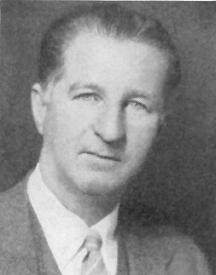 |
Honorary Member George E. Sterling Peaks Island, ME Q# 00223 (1948) Q# H0002 (1957) OOTC #51 2nd President 1950-1952 |
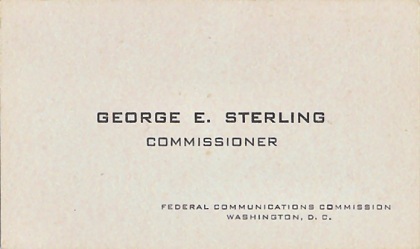 |
George Edward Sterling was born on Peaks Island located off the southern coast of Portland, Maine on June 21, 1894. He was the son of Wesley and Annie (Tatman) Sterling. George attended public school on Peaks Island. In 1908, the year amateur radio was born, at age 14, George was among the first amateurs to "hit the airwaves" using the new wireless communication medium. In the beginning, amateurs were unlicensed. They were people who experimented with and furthered the development of the new wireless technology (it was refered to by amaturs back then as the "radio art") demonstrated by Marconi a few years earlier. At age 18, George received one of the first amateur radio licenses (1AE) issued by the Department of Commerce Radio Service, Bureau of Navigation, after the passage of the Radio Act of 1912. The Radio Act of 1912 was the first attempt by the government to regulate amateurs and control the growing interference problem between amateur, commercial, and military radio users. The new law required amateur radio operators to register with the government to obtain a license to operate their transmitters and abide by the newly enacted radio regulations. The new regulations required amateurs to limit the DC input power of their transmitter to one kilowatt and limit their wavelength of operation to 200 meters and wavelengths shorter than 200 meters. At the time it was believed that wavelengths shorter than 200 meters were useless for long distance communication (long distance in those days was a few hundred miles). George operated a spark station with the callsign 1AE during these pioneering days of radio.
After he graduated from high school, George enlisted in the Maine National Guard and served with the Second Maine Infantry. In 1916 he served on the Mexican border with Company "M" of the Second Maine Infantry which served as a security force in places like Loredo and Zapata Texas. They patrolled the Texas border during the Pancho Villa raids on the mexican border towns of Texas.
In April 1917, George was a junior operator on the passenger steamship Philadelphia on the Red-O-Line operating out of Brooklyn, New York to Puerto Rico and several ports in Venezuela. It was on this ship, in February 1902, that Marconi had demonstrated that wireless communication could be achieved across the Atlantic Ocean. On April 6, 1917, during the return voyage from South America, his ship received coded orders to paint the ship in Navy colors and sail without lights. The United States had declared war on Germany. Immediately upon his return to New York, George tried to enlist in the Navy but was told that he had to be discharged from the Maine National Guard before the Navy would take him. He felt that his experience as a radio operator could be better utilized in the Navy. Later that year he requested a transfer to the Signal Corps but his commander would not release him.
In September of 1917, the Second Maine infantry set sail to France as the 26th Division of the 103rd infantry. In France, George was sent to the French Corps Specialist School where he learned French Army Signal tactics. After completing this training he was assigned to the Army Signal Corps, American Expeditionary Forces (AEF), where he served for 19 months as an instructor of wireless at the 1st Corps school in Gondrecourt, France.
During his tour of duty in Gondrecourt he revived a boyhood interest in aviation. After several unsuccessful attempts to transfer into aviation as an "observer", one who corrects artillary fire by wireless signals from an aircraft, he attended Officer's Training School in Langres France and was commissioned as a Second Lieutenant and assigned to General Pershing's headquarters in Chammount, France. From there he went to the front line to organize and operate the first radio intelligence section of the Signal Corps in France which located enemy radio transmitters and intercepted their message traffic. For this work he received a citation from the Chief Signal Officer of the AEF for "espically excellent and meritorious service."
During World War I, George's military duties took him to England. It was there that he met a ballet dancer named Margaret Farray who would later become his wife. George and Margaret were married in a church in Welland, Ontario on Christmas Eve in 1924. The two photos below of Margaret were taken around 1920.
After World War 1 George continued his association with radio while working as a radio operator in the Merchant Marine. In the early 1920s after the wavelengths shorter than 200 meters were pioneered by amateurs and transatlantic HF communication became commonplace, George held the call W1AE.
George began his federal career in 1923 with the Bureau of Navigation, Department of Commerce where he worked as a marine radio inspector in Baltimore, Maryland. There he attended John Hopkins University Night School and Baltimore City College. It was during this period that he held the call W3DF. From 1927 to 1936 he worked for the Federal Radio Commision (the predecessor to the FCC) as Radio Inspector in Charge at Fort McHenry for the third radio district. In 1937 he was promoted to Assistant Chief of the Field Division of the engineering department of the Federal Communications Commission (FCC) in Washington, DC. The Field Division handled the administration of the 21 field offices and several monitoring stations.
In the face of the alarming use of radio by Nazi spies in Europe and the special problems at home, the FCC acted to put the country in a state of radio preparedness. A plan was prepared to modernize and increase the number of monitoring stations and provide mobile units for at least one station in each of the States to do local investigative work and pinpoint illegal stations and sources of interference. The plan was submitted to Congress and was approved. In June 1940, President Roosevelt allocated 1.6 million dollars for radio defense efforts and established a new section within the FCC, the National Defense Operations Section (NDO) to augment the FCC's monitoring network. George Sterling was appointed to lead this new section of the FCC and was promoted from Assistant Chief, FCC to Chief NDO.
To obtain the personnel needed for the NDO, George Sterling instructed one of his assistants to search the file cards containing information on licensed amateur and commercial radio operators. More than 500 names were selected from the files and telegrams were sent to those selected offering them positions in NDO. Those positions were radio operator ($1800 per year), Assistant Monitoring Officer ($2400 per year) and Monitoring Officer ($3200 per year). The entire complement of NDO personnel were obtained from responses to those telegrams. NDO monitoring operations began on September 3, 1940. Later that year NDO was upgraded from a Section to a Division becoming the Radio Intelligence Division (RID) and George Sterling became its Chief.
The RID's charter was to investigate and monitor clandestine radio operations in the United States and it's possessions. As the war progressed it would also take on the task of training military personnel and intelligence agents in radio intelligence, monitoring and radio direction finding techniques. During this period George Sterling established a special branch of the FCC to handle amateur radio affairs.
After the bombing of Pearl Harbor on December 7, 1941, the FCC was called upon to support military radio intelligence efforts. Immediately following Pearl Harbor, the FCC mobilized a group from both the primary and secondary monitoring stations to go to the Hawaiian Islands on a two year detail to set up eight new monitoring stations, one each on Oahu, Molokai, Kauai, Maui and Lanai and three on the main island of Hawaii. George Sterling (W3DF) accompanied Prose Walker (W2BMX), Charlie Ellert (W3LO), Walt Maxwell (W8KHK) and other RID personnel who boarded a navy ship in San Francisco and sailed to Hawaii to begin the process of setting up a network of monitoring stations on the western front.
George Sterling appointed Charles Ellert, a John's Hopkins engineering graduate was Technical Advisor. Ellert was the person responsible for improving the accuracy of the Adcock direction finder antennas and for developing the "Snifter", a simple receiving device worn under the coat or around the waist which was used for pinpointing the location of illegal transmitters up-close in buildings, etc.
Before and during WW2, Mr. Manuel Kann (W3ZM) of Baltiomre assited George Sterling with the manufactire of aperiodic receivers and parts for the Adcock direction finders, running the manufaturing business out of the basement of his home in Baltimore. After the war, Manuel Kann and Charles Ellert opened an electronics store in Baltimore named Kann-Ellert which was located on TV hill in Baltimore City. (Note: When I was studying for and obtained my first licensed I shopped in their store for radio equipment in 1967-69. I purchsed all of my novice crystals there.)
In 1946 George Sterling served as a delegate of the Provisional International Civil Aviation Organization at the Demonstrations of Radio Aids to Air Navigation conference held in London, England. The same year, he served as chairman of the United States delegation to the engineering conference looking toward the third NARBA meeting which convened in Havana, Cuba in November 1946. The North American Radio Broadcasting Agreement (NARBA) was a treaty enacted in 1941 between the U.S, Canada, Mexico, Cuba, Dominican Republic, and Haiti to regulate the allocation of frequencies to AM broadcast stations in these countries. In April 1947 George was promoted to the position of FCC Chief Engineer.
In January 1948, after the extremely successful era of the RID, President Harry Truman appointed George Sterling as Commissioner of the Federal Communications Commission to replace Commissioner Ewell K. Jett who resigned on December 31, 1947 to become vice-president and director of the radio division of the Baltimore Sun Newspaper. The following year, George was nominated by President Truman and confirmed by the Senate to serve a full seven year term as Commissioner. George served as FCC Commissioner from January 2, 1948 to September 30, 1954. He has been the only amateur radio operator to work his way up through the ranks and serve as FCC Commissioner.
During the late 1940s, the United States was experiencing explosive growth in the television industry. In 1948 a black and white 19 inch RCA console television cost about one thousand dollars. This was a large investment for the average working person yet television gradually swept the country from coast to coast and changed American social habits in many ways. One social habit that was forever changed by television was the family dinner hour. People didn't want to miss their favorite TV programs while they ate dinner so the "TV tray" was born and meals were eaten around the TV set. George Sterling was the first person to introduce and demonstrate the operation of a television receiver to the residents of Peaks Island.
George retired from the FCC on September 30, 1954. A write-up announcing his retirement and highlighting his career appeared in the "It Seems to Us" column of the November 1954 issue of QST.
In addition to his distinguished federal career, George Sterling was a well known author. During the early years of his federal career he authored "The Radio Manual", a reference book which covered all aspects of radio communication, equipment and procedures in the early days of radio. This book became the recognized standard textbook of the radio industry and reference book for colleges and universities. The first edition was published in 1928 and was re-printed several times through the third edition which was published in 1940 and reprinted several times during the 1940s. Many of the book's chapters were written and edited by George's colleagues who were recognized experts in their field.
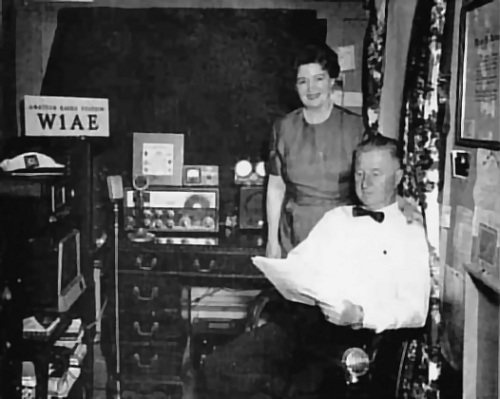 In addition to his book, George wrote about his experiences during his distinguished career. At the time these articles were written, they were published in classified publications. Many of his classified writings have been de-classified and made available to the general public. Two of George's RID collegues, Merle Glunt (W3OKN) and Al Evangelista (W3ZIP) have complied George's notes and files and published a document about the Radio Intelligence Division which describes the history and accomplishments of the RID. Copies of this material can be purchased through Merle (W3OKN).
In addition to his book, George wrote about his experiences during his distinguished career. At the time these articles were written, they were published in classified publications. Many of his classified writings have been de-classified and made available to the general public. Two of George's RID collegues, Merle Glunt (W3OKN) and Al Evangelista (W3ZIP) have complied George's notes and files and published a document about the Radio Intelligence Division which describes the history and accomplishments of the RID. Copies of this material can be purchased through Merle (W3OKN).
In the 1920s and 1930s during his career as a radio inspector with the Federal Radio Commission, and later the FCC, George lived in Baltimore- Washington area of Maryland. Later in his career he lived near Washington DC in Silver Spring, Maryland, only a few blocks from where I worked during 1992 to 1996 for the Department of Commerce/NOAA. George also spent some time in Falls Church, Virginia.
After his retirement from the FCC, George returned to his home in Peaks Island, Maine. There he spent time with his family, enjoyed fishing, amateur radio, and writing articles which appeared in various publications describing his many experiences during World War I, with the RID during World War II, and his long career with the Commerce Department and FCC. During his retirement years, George was active in the QCWA Yankee Chapter #112 and Pine Tree Chapter #134, the Old Old Timers Club (OOTC), The First Class Operators Club (FOC), and the Radio Club of America. During the 1960s George resided in Sarasota, Florida during the winter months where he was a member of the Sarasota Amateur Radio Association. During this time he held the call W4AE. In 1985, George received the QCWA Hall of Fame Award. Toward the end of his life he resided in a retirement home in Portland, Maine, but took mini-vacations with his family away from the home from time to time. George passed away in November 1990 at the age of 96.
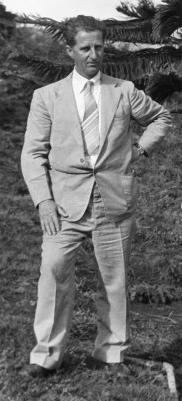 The Punch Bowl Hawaii |
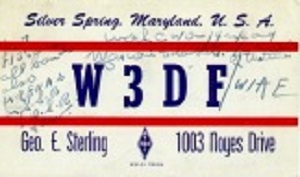 | |
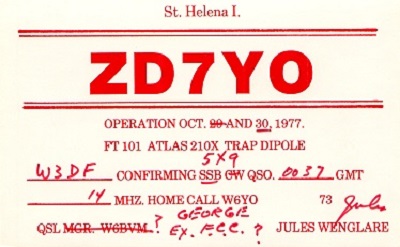 |
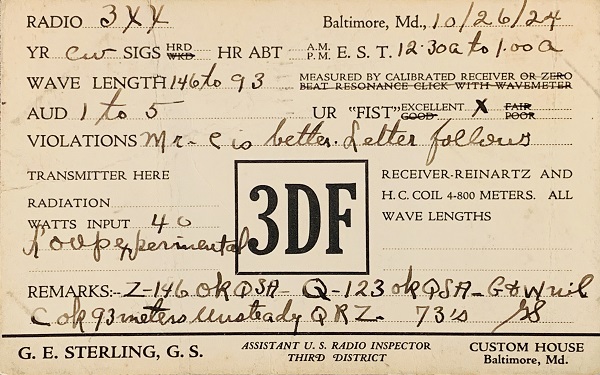
From the personal collection of Brian Duddy - N2BTD
Amateur Radio Historian and Preservationist
tnx Brian es 73, Bob, NØUF, Webmaster
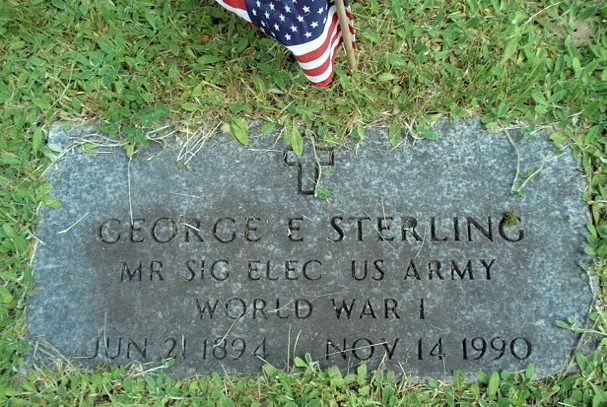

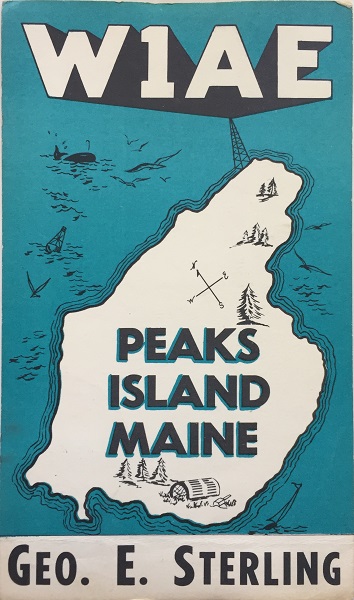
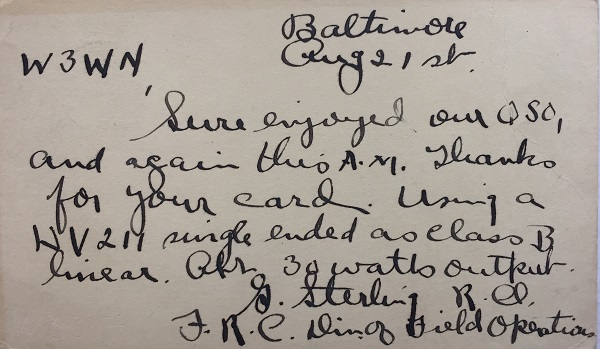
W1AE QSL provided by Pete, NL7XM